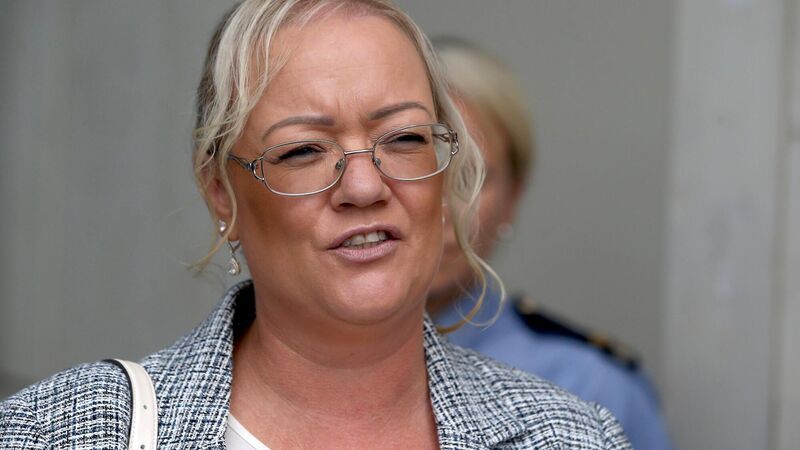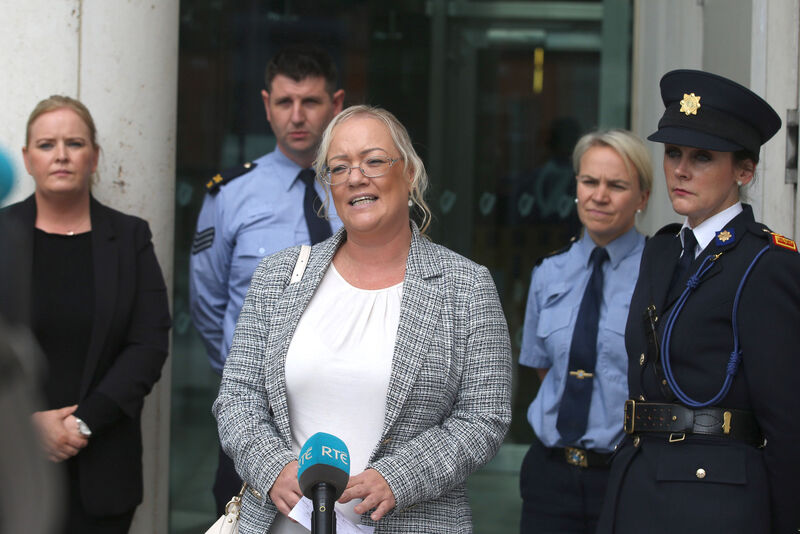Joyce Fegan: We should ask abusers and their supporters what they think they're doing

Sinéad O'Neill spoke up on Thursday after Dean Ward was sentenced to 18 years in jail for abusing her. She praised the gardaí's support and urged others being abused to come forward. Picture: Collins Courts
Most people enter relationships for love, compatibility, and companionship. But some people do it for control.
Many myths abound about crime and abuse in a domestic setting — “drugs and booze made me do it, your honour”, or “it was a momentary loss of control for my client, a crime of passion if you will”, or “it takes two to tango”.
Two court cases in Ireland this week blew these myths wide open, showing abuse for what it truly is: A choice, a need to control, to assert power over another.
There is nothing impulsive about it: It is considered, it is planned. Its tools vary from physical to sexual violence, and from digital to financial abuse. But the underlying goal is control, by whatever means.
This week, disgraced garda Paul Moody was sentenced to three and a quarter years in prison, having pleaded guilty to coercively controlling a woman.
In evidence, it was heard that the woman, who was sick with cancer, was beaten, kicked, punched, and choked over a four-year period.
Moody sent more than 31,000 threatening, abusive, degrading, and demeaning texts and phone communications to his victim. He informed her that he hoped she would “die of cancer” and “die in pain”.
Other actions included taking photographs of her naked and threatening to circulate them online.
He stole her cancer medication, which she could not afford to replace.
And he walked into the hospital where she was receiving treatment to inform her he was only visiting to watch her “bleed to death”.
Moody’s was a predictable, consistent pattern of behaviour, intentional and premeditated. Asserting control, not care, over another human being is the sole goal of abuse.
And it is not like other crimes, where you race to the nearest garda station when someone mugs you or after you walk home to discover your house has been burgled.
With coercive control comes the wrap-around layer of confusion, doubt, and loss of clarity: “Maybe it’s all in my head”; “Did I do something to provoke them?”; “I’ll destroy our entire family if I speak out.”
The abuser seems to be winning every which way: Not held responsible for his own crimes, and even if it goes to court, he might have people who have his back.
Moody’s victim spoke out under the condition of anonymity, and in her statement she mentioned that the perpetrator had support.
She told RTÉ she cannot understand how some people continued to support him when they knew what was going on.
She said that a number of men, not members of the gardaí, supported Moody during the criminal process even after he admitted what he had done. The victim is not the only person at a loss to explain people’s behaviour.

We look for motives to crimes, be it for land/property, or for revenge. We look for mitigating factors, histories of all sorts. We try to make sense of senseless acts.
In Moody’s case, Judge Martin Nolan described him as a “bully”. He said it was hard to imagine why he did what he did, but at the end of the day, he had done it.
In a second case this week, Dean Ward was sentenced to 18 years for coercively controlling, raping, and assaulting Sinéad O’Neill over a six-week period.

His considered, non-impulsive actions included removing Ms O’Neill’s contraceptive device as she slept.
He inundated her with communication, monitoring her whereabouts.
He sent her hundreds of messages, and 165 on one particular day.
The abuse was as much virtual as it was physical: Ward added Ms O’Neill’s friends to his Facebook account, and attempted to interfere with her online banking.
He sprayed her face with mace when she confronted him about the Facebook activity; when she locked him out after he tried to access her banking, he climbed into her home via a window, punched her in the head, tied her up, and raped her.
For perpetrators of abuse, they see themselves as “blameless victims” who lash out as soon as their crime is confronted. They make the victim feel like they are the bad guy. Ward maintains his innocence, rejects the verdict of the jury, and shows no remorse.
Sinéad O’Neill said it took just six weeks for this man to “take away all my independence, dignity, and control of my life”.
“I felt helpless but I now know there is a lot of support out there for women in these situations,” said Ms O’Neill.
Explaining why she had waived her anonymity, she added:
, by Cambridge University professor Mary Beard, charts the history of women’s public speech, the right, or not, to use their voice, from Twitter trolling all the way back to ancient Rome. In it, she traces the roots of misogyny.
Women were silenced and ridiculed from as early as Homer’s Odyssey. But Prof Beard found two exceptions to the social ban on, and ridicule of, women talking in public: Women were only given the ‘mic’ as martyr or victim.
When you look around at the level of gendered abuse today, not a whole lot has changed.
And in 2022, many women do not speak out or report abuse, for fear of not being believed or for fear of the consequences for the family, in the workplace, and in the wider community.
Perhaps many people would not have to endure such abuse, go through criminal trials, waive their right to anonymity to receive the pulpit, if we, as a society, believed victims, took earlier action, and didn’t respond with cliched catchphrases such as: “Have you thought about what saying something might do?”
It’s time we started asking the perpetrators and their bystanders and supporters: “Have you thought about the consequences of your behaviour?”
• If you are affected by any of the issues raised in this article, please click here for a list of support services.














